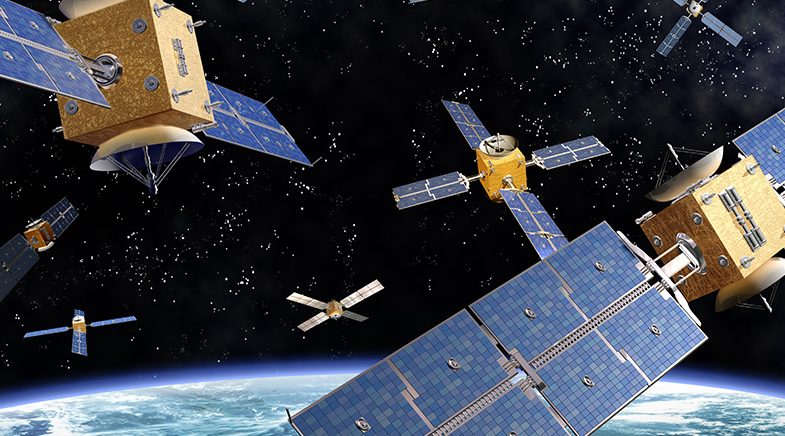A life mission
-
- from Shaastra :: vol 03 issue 10 :: Nov 2024

Europa Clipper is in search of life on Jupiter's moon.
One of sci-fi's favourite topics is getting a new lease of life. As NASA's Europa Clipper heads towards Europa, there is growing interest in the prospect of life on Jupiter's icy moon.
The spacecraft blasted off aboard a SpaceX Falcon Heavy rocket from the Kennedy Space Center in mid-October 2024. The launch vehicle pulled off an engineering miracle by catching its returning Starship booster in mid-air with a robotic arm nicknamed Mechazilla.
The $5.2-billion mission seeks to find signs of life on Europa. "Scientists are hopeful that Europa, with its vast subsurface ocean beneath an icy crust, might harbour conditions that could support microbial life, either now or in the past," says astrobiologist Siddharth Pandey, Space Systems Engineer at Fugro SpAARC in Perth, Australia. He refers to the recent discovery of liquid water oceans underneath the crust of Europa and Saturn's moon, Enceladus. "These are high-priority targets for life-detection missions in our solar system."
The spacecraft, which will travel 2.9 billion km, carries the largest solar arrays NASA has ever used for an interplanetary mission. With arrays extended, the spacecraft spans 30.5 metres. It is expected to reach Jupiter in April 2030 and, in 2031, commence its science-dedicated flybys to Europa — that is, zip by Europa taking measurements at its closest approach point.
Scientists believe Europa may have an environment suitable for habitability, for it seems to have all the three elements needed to support life: subsurface water, chemistry, and energy. "Habitability is... having the right conditions that can support life as we know it: a stable source of energy, the presence of liquid water, essential chemical elements, and an environment that allows biological processes to occur," Pandey explains.
Its icy crust is 15-25 km thick, making the ocean relatively close to the surface. The ocean is in direct contact with a warm rock seafloor. Geologic activity, if present, may transport surface compounds to its ocean. Essential chemical building blocks for life possibly exist. Europa's energy input might come from surface chemistry and water-rock interactions on the seafloor.
CLUES FROM THE PAST
Previous spacecraft observations of Jupiter and its moons have provided important clues. In 1979, images from NASA's Voyager 2 mission showed ridges on Europa's surface, implying geologic activity. In 2012, Hubble Space Telescope data indicated possible water vapour plumes erupting from the surface. In its multiple flybys from 1995 to 2003, NASA spacecraft Galileo found strong evidence of an ocean: an induced magnetic field was created possibly by a salty water layer under the ice.
"One of the critical objectives of the mission is to study Europa's magnetic field, which plays a key role in understanding its subsurface structure," says Madhulika Guhathakurta, Senior Advisor at NASA Heliophysics. She explains that Europa orbits within Jupiter's powerful magnetosphere, and as it does so, Europa interacts with the magnetic environment. "This interaction induces secondary magnetic fields in Europa, providing insights into what lies beneath its icy crust," she says. She adds that Europa Clipper seeks to measure these fields to understand the subsurface ocean's nature, depth, and salinity.
Jupiter's magnetic field, which is 20,000 times stronger than the Earth's, could, however, cause significant damage to the spacecraft. So, the payload and electronics have been enclosed in a thick-walled titanium radiation vault for protection. The mission will fly by Europa only once every two weeks to spend less than a day at a time in Jupiter's field. A planned total of 49 flybys will map nearly the entire moon.
The mission's primary science objectives are to understand the nature of the ice shell, the ocean beneath it, and the moon's composition and geology. It will explore the moon with an array of nine instruments, including cameras and spectrometers, to produce high-resolution images of the surface and its thin atmosphere; ice-penetrating radar to search for subsurface water; and a magnetometer to conduct gravity studies of its ocean and deep interior.
If this mission does yield signs of habitability, future projects could be more specialised, focusing on direct sampling and analysis, seeking definitive biosignatures confirming life, Pandey reckons. "Future missions could include landers or sample-return capabilities."
Discovering habitable conditions would redefine scientists' understanding of biology and the potential for life beyond Earth, he adds. "It would open new scientific frontiers, inspire technological advancements for further exploration, and shape our perspective on humanity's place in the universe."
Mila Mitra is a former scientist at NASA GSFC and Co-Founder of STEM & Space.
Have a
story idea?
Tell us.
Do you have a recent research paper or an idea for a science/technology-themed article that you'd like to tell us about?
GET IN TOUCH














